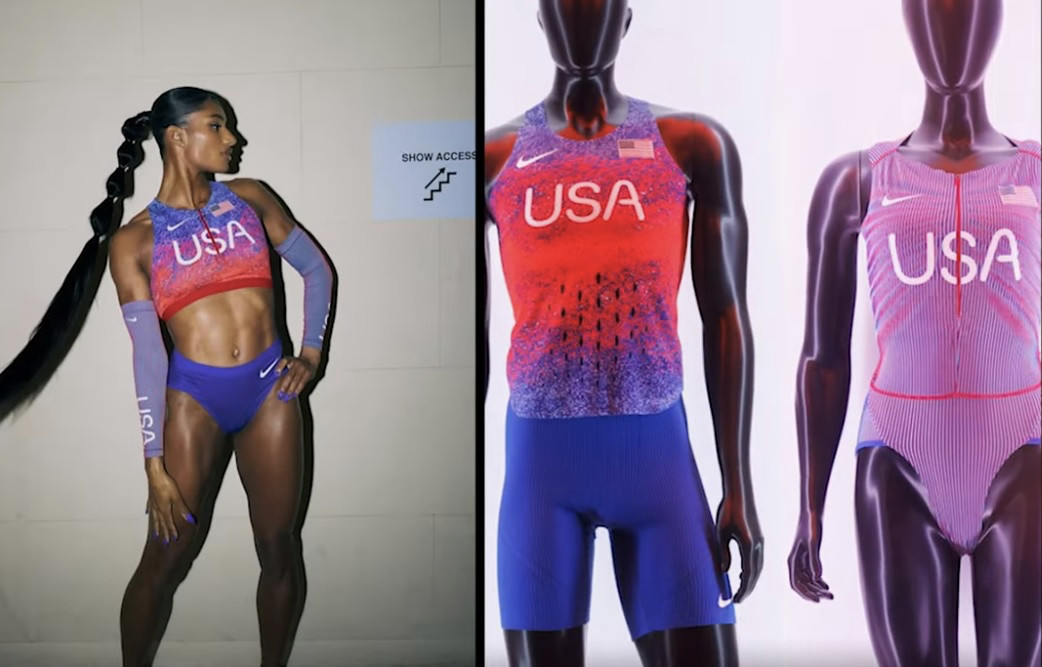New US Women’s Athletics Olympic Uniforms Get Backlash: Is This Move Away from Women’s Equality in Sports?
The Team USA women’s athletics squad’s outfit designer, Nike, has come under heavy fire for the provocative design.

The USA women’s track and field team’s uniform dispute has drawn attention as competitors from all over the world prepare for the much-awaited Olympic Games in Paris where the United States is expected to dominate in this sport—actually, just like the entire US Olympic team, predicted to win close more 120 medals—with Athing Mu, Sha’Carri Richardson, etc. as early favorites in their respective disciplines by online sportsbooks with betting bonuses in the form of free bets.
Nike debuted its 2024 national and federation kits at the “Nike On Air” event in the French capital, where it was joined by over 40 elite athletes. More than 100 federations in team and individual sports collaborate with Nike, and the company also provides support to hundreds of individual athletes participating in the games. Given that the men’s uniform has longer shorts than the women’s, Nike’s high-cut design of the US outfit—a leotard—has drawn criticism.
American long jumper Tara Davis-Woodhall said that her “hoo-haa (slang for vagina) is gonna be out” in response to exhibiting the leotard on Instagram by media outlets prior to the event in Paris.
American Paralympic sprinter Jaleen Roberts also added her commentary, stating that in spite of the mannequin’s standing position all intimate parts are exposed, one should “imagine mid-flight (slang for spread legs).”
Nike Defends Its Choices
Nike defended its design decisions at the uniform’s unveiling, saying that the products were the outcome of thorough testing and player consultations.
According to the company’s Chief Innovation Officer John Hoke, Nike prioritized performance and maximum breathability when designing the Paris 2024 track and field uniforms. These styles are suited for different sports disciplines, body types, and sizes. For female athletes, the uniform line offers more than 25 stylistic combinations and multiple layering choices.
The larger issue is this: Leotards are “a costume born of patriarchal forces that are no longer welcome or needed to get eyes on women’s sports,” as former long-distance running star Lauren Fleshman put it when pointing out the disparity between the men’s and women’s outfits.
Is Women’s Sportswear Moving in Direction of or Away from Emancipation?
Sport for women is slowly stepping out from under the shadow of sport for males. Nonetheless, it’s a reflection of social conventions and gender differences. Because of this, it’s nonetheless deeply misogynistic.
The increasing volume of testimonies from female athletes demonstrates how women are becoming more and more sexualized, especially in light of the sportswear that is expected of them. Although not nearly enough, the fight against this outdated perception of women and sports has gained steam and yielded tangible, positive effects.
Here, we examine the difficulties surrounding the evolution of sportswear over time.
Centuries-Long Evolution of Women’s Sportswear
Between the 19th and the present, there have been significant developments in sportswomen’s apparel. Nevertheless, the majority of clothing progressed in the direction of sexualizing women rather than just being better tailored to the physiology and performance of women:
Sportswomen dressed in long, corseted gowns, boots, and caps for a variety of activities in the 19th century, including riding, hunting, and tennis. In order to avoid dressing in a too suggestive manner, women had to adhere to strict etiquette norms, but they also couldn’t dress like males.
Women’s attire was regulated by the International Olympic Committee at the start of the 1900s. They weren’t to divert the attention of the male competitors.
Women’s attire remained tight after the Olympics, although it became more functional.
By the end of the 20th century, women’s fashion in sports continued to advance in practicality. However, when new fabrics were available, clothing also grew more form-fitting and exposed, with a focus on showcasing their bodies and hugging their curves—a shift from the utilitarian to the fashionable.
The pattern is still in place at the start of the 21st century. Some’s sexist goals are blatantly obvious. Sepp Blatter, the president of FIFA, stated in 2004 that he preferred female football players to wear tighter shorts in order to draw sponsors.
Women’s Initiatives to Bring About Change
Despite basic logic, an increasing number of sportswomen are attempting to escape from the chains of the clothes that are forced upon them. They encounter a particular brand of conservatism. But with persistence, some strides have been achieved, and the outcomes are starting to look promising. To give an example:
Due to medical concerns after giving birth, at the 2018 Roland Garros, American tennis player Serena Williams wore a full black jumpsuit with a red waistband. She received a lot of backlash for not dressing in accordance with the French Tennis Federation’s dress code. It wasn’t the first time in this sport: tennis player Anne White faced backlash in 1985 for dressing in a jumpsuit rather than a white skirt.
The Dutch beach handball team refused to wear a bikini at the 2021 European Championships; instead, they competed in shorts. The European Handball Federation consequently penalized them EUR 150, despite the fact that males are permitted to wear shorts. The governing body only agreed to amend the uniform regulations following months of persuasion and a petition.
The same year, German gymnasts used full-body suits instead of leotards when they competed in the Tokyo Olympics. Although this uniform complied with federation regulations, it was rarely worn.
Recently, football players have voiced their opposition to wearing white shorts. During the 2023 World Cup, it was clear that the squad uniforms of England, New Zealand, Canada, France, the United States, and Nigeria didn’t have white shorts. Some of these federations rejected white shorts for the first time since the WWC originally started in 1991.
Problems with Sportswomen’s Attire and Significance of Their Decision in This Regard
Some people may find the topic of sportswomen’s attire anecdotal. Far from it, actually.
Men still hold much too much power over the rules governing women’s sports, as seen by the fact that sportswomen have only recently been granted the ability to choose what to wear. Women’s sports fashion choices are a crucial liberation vector. Given that sportswomen’s attire not only affects their performance but also directly affects the quantity of sportswomen, this decision is even more crucial.
It’s true that several sports, including beach volleyball, gymnastics, and athletics, discourage young girls and women from starting or continuing these activities since they demand them to wear skimpy apparel. Inappropriate attire has one main effect on sportswomen’s performance, even in cases where it doesn’t deter women from beginning or continuing a sport: Women’s attention can’t be fully directed into their sporting activities and performance when they are dressed in uncomfortable clothing. They are concerned that their periods may affect these clothes, that they’ll lose some of them, or that a movement will expose some of their bodies.
Furthermore, the legitimacy of women’s sports is impacted by these unsuitable attires. The variations in attire are a reflection of a profoundly ingrained sexist perspective on women’s sports, which holds that the bodies and attire of the athletes are what’s seen and discussed rather than their results. A 2008 study found that numerous images taken during the 2004 Olympic beach volleyball matches emphasized the players’ bottoms or breasts.
Over time, sportswear has undergone significant change. But for a long time, women have not benefited from this evolution. However, voices have been raised to develop clothing that’s adapted to women’s needs and preferences. Thus far, the measures and initiatives implemented have yielded positive outcomes. These campaigns need to go on in order to eliminate any concerns about what athletes wear. But once Nike unveiled the USA’s track and field uniforms, a step backward was taken…








